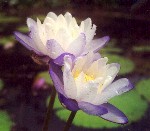
Field Collecting Australian
Waterlilies
Expeditions 2000, 2001
Text and most photos by Andre Leu
Click images to enlarge
One of my greatest joys in life is field collecting plants. My collecting trips have taken me and my wife Julia to many interesting places on this planet, such as along the Mekong in China, Laos and Cambodia, up the Mahakham river in Borneo and the upper parts of the Amazon basin in Ecuador. My specialty is collecting rare exotic tropical fruits and introducing them into horticulture. Water lilies are plants that I have always loved. I grow them for the intense enjoyment of the daily parade of new flowers.
Recently I have been very fortunate to go on collecting trips with two of the most knowledgeable world experts in water plants, Walter Pagels and Barre Hellquist. The first time I met Walter, when he visited my farm, he inspired me by telling me about a white Nymphaea gigantea that flowered 24 hours a day.
In 1946 Albert de Lestang, a plant collector who lived in northern Australia, sent waterlily seeds via Kew Gardens, London, to George Pring at Missouri Botanical Gardens. Pring sent half of his seeds to Arthur Proebstle in Texas, because the warmer climate would be better for growing these tropical lilies. Arthur Proebstle noticed that one of these white lilies, after closing for the first night, stayed open 24 hours a day for four to five days. Pring was so skeptical that he made a special trip to Texas to see it. This plant was propagated and cultivated in the USA for many years. However because it was hard to grow outside of a greenhouse, it proved to be unreliable in cultivation. Eventually it was only grown in a few botanical gardens until it was lost to cultivation. Nobody knew where it grew in the wild.
I was determined to go Albert De Lestang's property near Lawn Hill Gorge to try and discover this white Nymphaea gigantea that flowered 24 hours a day. In February 2000, I mentioned to Walter, in correspondence, that I intended to go to Lawn Hill in mid April. I felt that was the best time as the Monsoon season would be finished, and the lagoons would still be full of water. Walter replied asking if I would like a passenger, so we started planning the trip.
I live tropical north Queensland, 60 miles north of the city of Cairns, near a small village called Daintree. Although Australia is regarded as one of the driest continents, the far northern part of Queensland is a very wet area. The monsoon season had been unusually heavy and prolonged was still very active in late April. Starting in November 1999 we had averaged 36 inches of rain a month for five months, giving a total of over180 inches of rain during that period. Some towns had over 250 inches of rain that year. The day Walter flew out of Los Angeles in April 2000, a cyclone (hurricane) was forecast to hit us. Fortunately by the time Walter arrived after spending a few days in Sydney, it had passed over and our local airport was open again.
We started our journey by crossing the Atherton Tablelands
to Ravenshoe. This is Queensland's highest town, set at over 3000 feet. Although in the tropics, Ravenshoe
gets winter frosts. On previous visits I had seen blue flowering
Nymphaea immutabalis here, and I felt these plants would
have more cold tolerance and should be a better variety for introducing
into cultivation. Unfortunately, due to the unusually heavy monsoon
season, the constant flooding of the river systems meant that
there were no lilies to be found.
town, set at over 3000 feet. Although in the tropics, Ravenshoe
gets winter frosts. On previous visits I had seen blue flowering
Nymphaea immutabalis here, and I felt these plants would
have more cold tolerance and should be a better variety for introducing
into cultivation. Unfortunately, due to the unusually heavy monsoon
season, the constant flooding of the river systems meant that
there were no lilies to be found.
From here the journey took us down towards the Gulf of Carpentaria, which is 400 miles westwards. The Gulf region is much drier with a 3-4 month wet season and virtually no rain for the rest of the year. It is a Savannah climate like much of Africa or the Yucatan peninsular of Mexico. The area is mostly grassed woodlands with open small to medium sized (20-30ft) Eucalyptus and Acacia trees. It is rich in kangaroos, wallabies, parrots, lizards, snakes, crocodiles and other wildlife.We had to spend the night at Mt. Surprise because storms resulting from the cyclone had flooded the rivers and cut the road.
Next morning the rivers were low enough for us to carefully
cross the flooded bridges. We continued  across
the base of Cape York Peninsular to Normanton, examining every
pool and watercourse for aquatic plants. That afternoon we reached
Normanton where we found our first pure white waterlilies. We
found several pools covered in flowering lilies in shades of
white, blue and light pink. They were a spectacular sight.
across
the base of Cape York Peninsular to Normanton, examining every
pool and watercourse for aquatic plants. That afternoon we reached
Normanton where we found our first pure white waterlilies. We
found several pools covered in flowering lilies in shades of
white, blue and light pink. They were a spectacular sight.
The next day we traveled several hundred miles to Gregory Downs. This area is very sparsely populated and it is not uncommon to travel over 100 miles without seeing another car or person. There are great expanses of Savannah's and woodlands. Savannah's are tropical grasslands with very few trees. Due to the heavy monsoon rainfall they were full of rich tall grasses and fat cattle. The rainfall meant that the countryside was alive with native animals, such as black cockatoos, sulfur crested cockatoos, galahs (pink cockatoos) and other multi colored parrots and lots of kangaroos and wallabies.
We arrived just at sunset and headed for the local hotel. The lights were on, however all the doors and windows were locked. Walter and I called out and searched around. Eventually Walter found one of the employees who refused to give us a room because the owner wanted an early night's sleep and didn't want to be disturbed. She told us to sleep by the riverbank.
The general store had a sign advertising rooms, however it was closed and nobody was around. We went on a wild goose chase around this small town, trying to find the owner. Everybody was very helpful telling us where they thought she was, however she was not to be found in any of the recommended locations. She had disappeared in a town with less than ten houses. We had no option but to wait in front of the shop until she returned. Eventually after some hours we managed to get rooms.
Next morning, despite being warned that the road was impassable due to wet weather, we drove towards Lawn Hill and on to Adels Grove, Albert de Lestang's old property. This area is close to the Queensland - Northern Territory border. Adels Grove is run as shop/camping area. They had a scrapbook with copies of correspondence and biographies of Albert, which Walter and I read and took notes. We learnt that the name of his property, Adel, came from the initials of his name.
According to his notes, the seeds of the white flowered gigantea did not come from that area, but were collected by aboriginal people for him. Albert was very friendly with the local aboriginal people, who, in those days, had a permanent camp on the opposite bank of the large lagoon that bordered his property
I walked through the forest to the lagoon. It is a very attractive location, fringed with large eucalyptus, paperbark, pandanus and palm trees. I spotted flowering lilies near the opposite bank. Excitedly I returned to the shop and hired a canoe. After paddling for hundreds of yards and examining every lily, we only found the common light blue Nymphaea violacea. This is a very beautiful flower, however it was not what we were looking for. We did not find any white Nymphaea gigantea plants. We were not surprised as Albert de Lestang's correspondence stated that no white lilies were found in his area, only blue forms.
We drove around and spoke with local people about possible
locations of white flowered lilies. No one had ever seen them.
When we explained that the seeds were collected by aboriginal
people, we were told that they might have come from Domadgee.
Domadgee is a large aboriginal community over 100 miles north,
near the Gulf of Carpentaria. Due to rains the roads in that
area were impassable. We were  warned
that storms would soon make the road back to Gregory downs impassable.
In this very isolated part of Australia it is not uncommon for
roads to remain isolated for weeks and sometimes for up to 5
months. We decided to return to Normanton, as that was the only
place in over 700 miles of travelling that we had found white
waterlilies. On the return trip we found waterlilies at a place
called Sandy Creek, between Gregory Downs and Burke and Wills
Road House. This site had many colors, from dark blue, to almost
white and a very pale light pink. The flowers of this group faded
as they aged.
warned
that storms would soon make the road back to Gregory downs impassable.
In this very isolated part of Australia it is not uncommon for
roads to remain isolated for weeks and sometimes for up to 5
months. We decided to return to Normanton, as that was the only
place in over 700 miles of travelling that we had found white
waterlilies. On the return trip we found waterlilies at a place
called Sandy Creek, between Gregory Downs and Burke and Wills
Road House. This site had many colors, from dark blue, to almost
white and a very pale light pink. The flowers of this group faded
as they aged.
We finally arrived back at Normanton at about 8 p.m. and after booking into a motel and having a meal, we went down to the spot on the Norman river where we found the white lilies. To our surprise there were flowers that were still open. About 10% of the flowers were open. We had found a source of the 24 hour flowering plants, which was the main purpose of this trip.
The next day and night were spent searching for more areas with lilies. We discovered quite a few interesting things, including many types of Nymphoides and new locations for Nymphaea hastifolia. Previously it was only known in the top end of the Northern Territory.
It was in the afternoon of that day I discovered the deep
pink lily that William Phillips named after me. After I spotted
it. I showed it to Walter who watched out for crocodiles while
I waded in to collect it. I am very cautious when it comes to
crocodiles, as they are almost impossible to spot when they are
in the water. These animals are the masters of stealth and surprise
attacks. Over the years I had decided not to enter deep pools
to collect interesting lilies as the dangers outweighed any benefits.
However, having never seen a native Australian lily with such
dark pink flowers, I just had to take the risk.
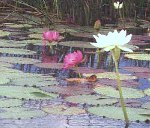 |
 |
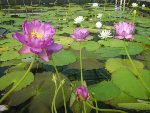 |
|
|
|
|
|
|
|
|
Throughout this collecting trip, we looked out for each other,
when one of us entered the water to collect. However in reality
if a crocodile was hiding close by, not much could have been
done to stop an attack, and probably all the survivor could have
done was told the story how the other person was taken. This
particular trip was very rewarding. We set out to with the difficult
task to find a very rare plant and managed to achieve it. Field
collecting is always an interesting exercise. Often the original
purpose is not always achieved, however other discoveries more
than make up for this.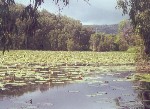
The one of the aims of the next trip, in March 2001 with Barre Hellquist, was to establish if the Keatings Lagoon at Cooktown was the most southerly point for Nymphaea atrans. This is a species that occurs in Cape York Peninsular with changeable flowers that open with blue outer petals and white inner petals. Over the course of four days these outer petals change to deep pink.
 I
met Barre, his wife Marion and one of his students in the town
of Mossman and we proceeded up the rainforest covered mountain
range to Mt. Molloy and turned north towards Cooktown. This area
is the inland route and is drier than the coastal range. The
countryside is covered in Savannah woodland. As we always do
on
I
met Barre, his wife Marion and one of his students in the town
of Mossman and we proceeded up the rainforest covered mountain
range to Mt. Molloy and turned north towards Cooktown. This area
is the inland route and is drier than the coastal range. The
countryside is covered in Savannah woodland. As we always do
on  these
sorts of trips, we slowed down and checked every watercourse
for lilies. The first site was about 1 mile north of Mount Carbine.
Here we found a lagoon system filled with Nymphaea violacea
and bird life. The flowers of this group were smallish and emerging
on the first day as medium blue and fading to a very light blue
by day 3.
these
sorts of trips, we slowed down and checked every watercourse
for lilies. The first site was about 1 mile north of Mount Carbine.
Here we found a lagoon system filled with Nymphaea violacea
and bird life. The flowers of this group were smallish and emerging
on the first day as medium blue and fading to a very light blue
by day 3.
We continued for many miles and spotted lilies in a dam. These
turned out to be some of the largest  Nymphaea
violacea plants we have ever seen with very pale blue, almost
white flowers more than 8 inches in diameter. These flowers did
not fade. Further along we came to a shallow pool where found
a miniature Nymphoides, possibly Nymphoides minima
and Monochoria cyanea. Monochorias are closely related
to water hyacinths however instead of floating they grow in the
margins or in shallow pools. They are very attractive plants
that flower everyday in the summer.
Nymphaea
violacea plants we have ever seen with very pale blue, almost
white flowers more than 8 inches in diameter. These flowers did
not fade. Further along we came to a shallow pool where found
a miniature Nymphoides, possibly Nymphoides minima
and Monochoria cyanea. Monochorias are closely related
to water hyacinths however instead of floating they grow in the
margins or in shallow pools. They are very attractive plants
that flower everyday in the summer.
The fourth site was at the Palmer River Road House. Here we found another type of Nymphaea violacea. The leaves of this type had a reddish brown under side, compared to the violet undersides of the other locations. The flower was a medium blue and only faded slightly with age. We crossed over the Great Dividing Range and were now in a catchment where the rivers flow into the Coral Sea and the Great Barrier Reef.
After many miles we spotted a pond with white lilies. On entering
the water we identified these as a mix of 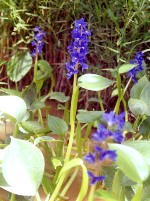 N.
immutabalis with pure white flowers or white with very light
blue outer petals. This pond also contained a form of Marsilea
drummondii with very large leaves.
N.
immutabalis with pure white flowers or white with very light
blue outer petals. This pond also contained a form of Marsilea
drummondii with very large leaves.
Further on at Kings Plains we found Monochoria australis.
This is the largest and most spectacular of the Monochoria
species. The plants were in full bloom with sprays of rich deep
blue flowers. I think this is one species that should be brought
into cultivation.
We reached Keatings Lagoon around 3 p.m. and it was a magnificent
site. This natural pond is shaped like a bow and is about 100
yards wide and 700 yards long, surrounded by tropical monsoon
forest. The lagoon was covered in flowering lilies. Fortunately
for us the National Parks and Wildlife Service have constructed
a crocodile fence at the water line. I presumed that this was
to ensure that visitors walking on the well constructed perimeter
track through the forest did not get eaten. Cooktown is trying
to develop a tourist industry and regularly losing tourists to
crocodile attacks would tend to retard things a bit.
Crocodiles are some of the most efficient and ferocious predators on the planet. They can spend days waiting under water at the same spot, with just their nostrils coming out of the water periodically. They are so well camouflaged that they are practically invisible. When a suitable prey comes into their range, they move with lightning speed, grab the prey and do a 'death roll' as they pull it under water. A few months ago one of the neighbors was fishing at her usual spot on the banks of the Daintree River with her dog on her side. Without warming a 15ft crocodile jumped out of the water, grabbed her dog and disappeared. It all happened in seconds. She was lucky that she had a dog by her side otherwise it could have been her.
Barre and I checked the lilies by the fence and found that
they were Nymphaea immutabalis, not N. atrans as
we had been hoping. Some of the forms of this of lily had characteristics
of N. atrans, in that the day one flowers start with blue
outer petals and white inner petals. The outer petals gradually
change to a light pink by day four, however this pink is not
as deep as the color of N. atrans. Most of the lilies
were  typical
of the more common form of N. immutablis, with various
shades of blue - from dark to light outer petals and white inner
petals. These colored outer petals usually fade very slightly
over the life of the flower and were the reason for the name
immutabalis. This species is very similar to N. gigantea,
however the seeds are smaller and usually the flowers do not
fade. I personally find this to be more reliable in cultivation
than N. gigantea.
typical
of the more common form of N. immutablis, with various
shades of blue - from dark to light outer petals and white inner
petals. These colored outer petals usually fade very slightly
over the life of the flower and were the reason for the name
immutabalis. This species is very similar to N. gigantea,
however the seeds are smaller and usually the flowers do not
fade. I personally find this to be more reliable in cultivation
than N. gigantea.
The following day Barre came to my house and after showing
him my ponds, we went to a series of ponds nearby. These ponds had been constructed for aquaculture and
were being used for Barramundi, a very popular eating fish, however
native water birds had seeded them with N. violacea and
N. nouchali. Our main purpose was to collect a rare pink
form of Nymphaea violacea. I have only ever found pink
flowered forms of this species in the Daintree River valley and
one other place near Mt. Molloy on the Atherton Tablelands.
nearby. These ponds had been constructed for aquaculture and
were being used for Barramundi, a very popular eating fish, however
native water birds had seeded them with N. violacea and
N. nouchali. Our main purpose was to collect a rare pink
form of Nymphaea violacea. I have only ever found pink
flowered forms of this species in the Daintree River valley and
one other place near Mt. Molloy on the Atherton Tablelands.
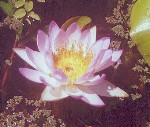 The
main pond was very clear and shallow, and it was highly unlikely
to have crocodiles. We were very fortunate as there were flowering
N. violacea plants with colors from the palest blue, through
to rich medium blues, lavenders and pinks. I never grow tired
of a pond full of colored lily flowers. It is always a magnificent
sight. We spent quite a while in the water of this pond looking
at the variations of the colors and collected plants and tubers
of the pink lilies.
The
main pond was very clear and shallow, and it was highly unlikely
to have crocodiles. We were very fortunate as there were flowering
N. violacea plants with colors from the palest blue, through
to rich medium blues, lavenders and pinks. I never grow tired
of a pond full of colored lily flowers. It is always a magnificent
sight. We spent quite a while in the water of this pond looking
at the variations of the colors and collected plants and tubers
of the pink lilies.
From here we drove back up the mountain range to Mt. Molloy where we headed slightly south to examine some seasonal ponds. I had located one of them by chance the year before and had collected a Nymphaea immutabalis that had pink outer petals and white inner petals there. This is a very rare plant, as both Barre and I had never seen one before. We searched the pond system extensively, however we only found the normal blue form of N. immutabalis and yet another different form of blue N. violacea. Unfortunately we did not find any pink flowered forms.
We then proceeded to another pond that Barre had known about on an earlier collecting trip. We had collected here two years ago, looking for a type of N. immutabalis with outer petals that change from blue to pink. On that earlier trip we also located pink flowering N. violacea and an orange flowered Nymphoides in this pond. This time the pond only had N. violacea, including pink and lavender forms and the Nymphoides. The N. immutabalis were still in first floating leaf stages. When Barre first saw the pond several years ago, it only had N. immutabalis and no N. violacea. When he showed it to me two years ago it was mostly N. violacea with some immutablis in flower.
This is now my third year of studying this seasonal pond.
When it fills with water at the start of the monsoon Nymphaea
violacea is the first lily to germinate and flower. As the
weather gets cooler and sunnier, the N. immutabalis plants
increase in size and begin to flower. This pond is set at about
1000 ft above sea level and
winter night temperatures can drop to the low 30s F. This is
too cold for the N. violacea plants and they go dormant.
By mid winter the pool is dominated by N. immutabalis
plants. They continue to flower prolifically until the pool dries
up in September. The ability of N. immutabalis to continue
to flower in the cooler tropical winter months and tolerate near
frost conditions, is the reason why I think it is the Australian
species that should be introduced into horticulture.
and
winter night temperatures can drop to the low 30s F. This is
too cold for the N. violacea plants and they go dormant.
By mid winter the pool is dominated by N. immutabalis
plants. They continue to flower prolifically until the pool dries
up in September. The ability of N. immutabalis to continue
to flower in the cooler tropical winter months and tolerate near
frost conditions, is the reason why I think it is the Australian
species that should be introduced into horticulture.
I have now cultivated all Australian species except for N. atrans and N. elleniea. I find that N. immutabalis is the easiest and most reliable to grow out of the Anecphya sub group of water lilies. One of the things that I find is very interesting in field collecting Australian waterliles, is the great variations at most locations. Nymphaea violacea is a very variable species, and it is possible to find slightly different characteristic at most locations. I believe that more taxonomic work is needed on this species.
The lilies from the Norman River (the 24 hour, white and pink) also need more work. For the sake of this article I called them Nymphaea gigantea. However they have some significant differences, in that the petals are wider and straighter, the seeds are much smaller and the new leaves are red. Walter and I found that they did not correspond with to the descriptions of the three gigantea related species, N. gigantea, N. immutabalis and N. macrosperma. They could be a new species or a sub type of one of the species.
The Australian lilies have proved difficult to cultivate, because they tend to go dormant and form tubers for the slightest of reasons. I believe that this is a response to vagaries of the climate in many parts of this continent. They have to cope with drought, floods and cold spells. However in the last few years we have collected and introduced many new species and color forms into cultivation in Australia and the USA. Through this effort more reliable plants are being brought into cultivation. I look forward to seeing more of these spectacular flowering waterlilies in garden ponds around the world.
|
|
|
|
|